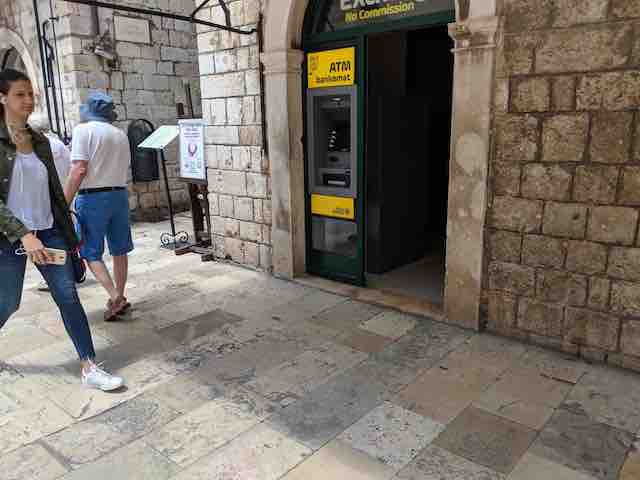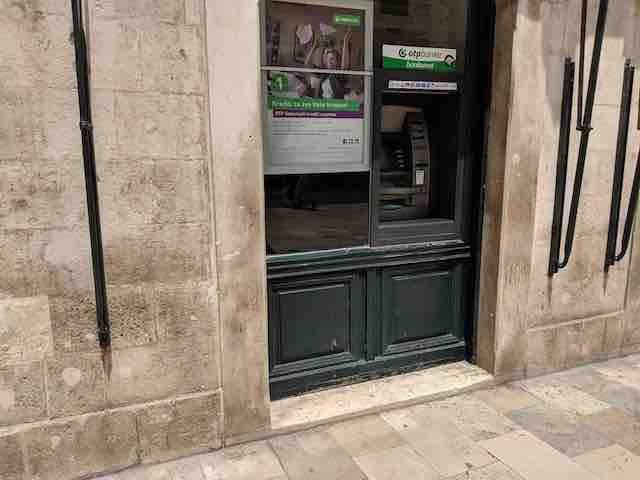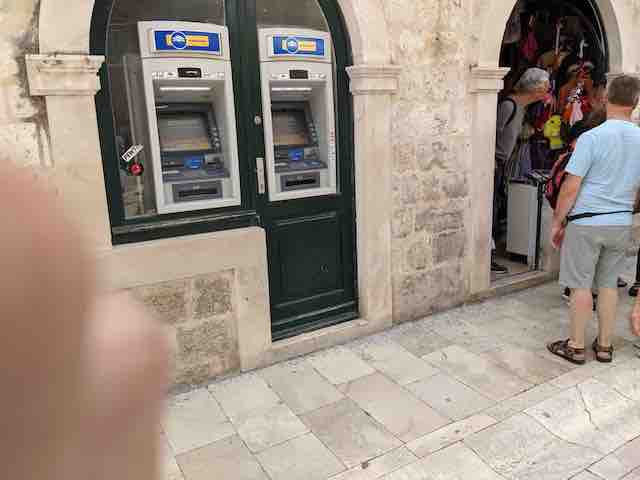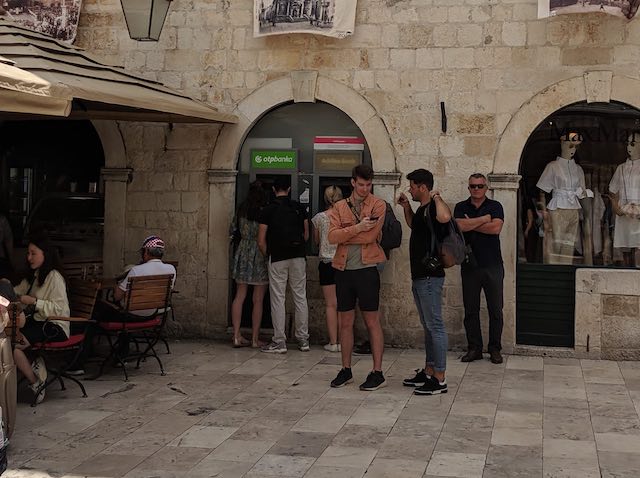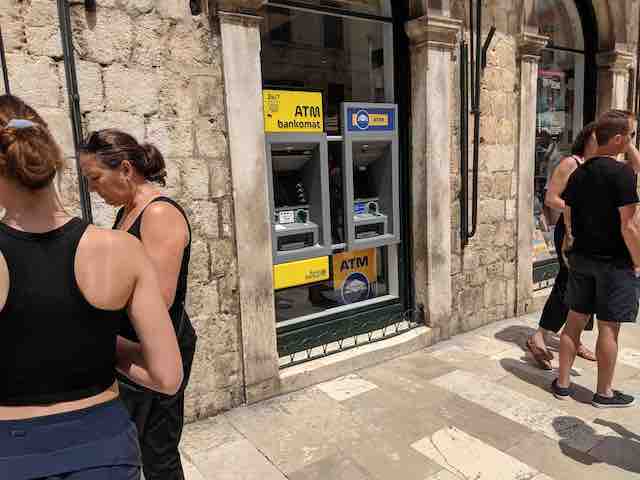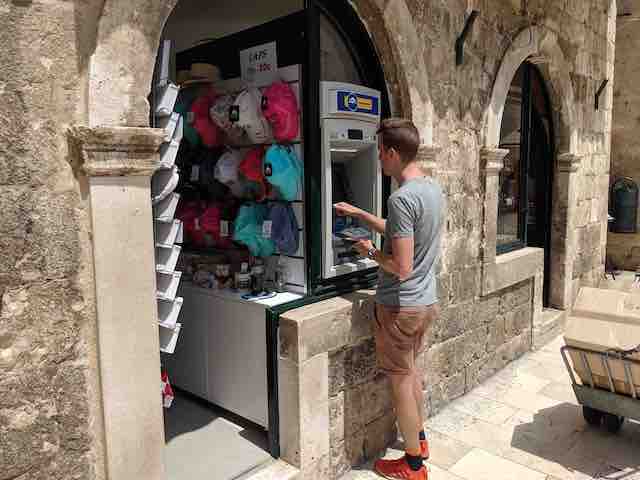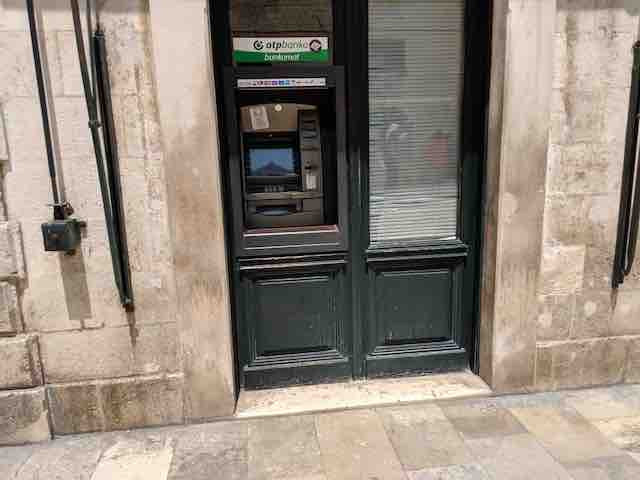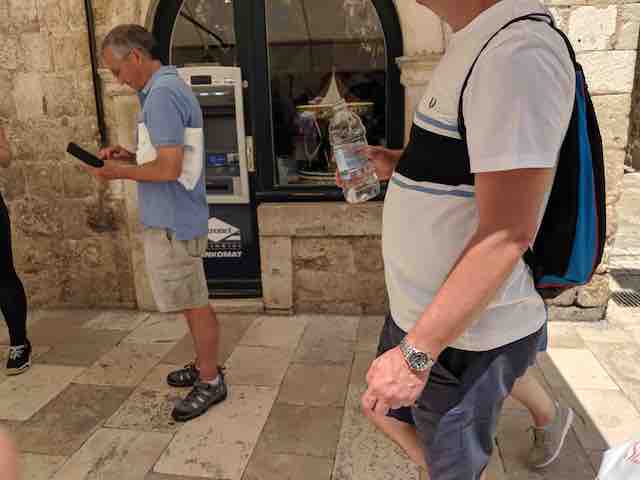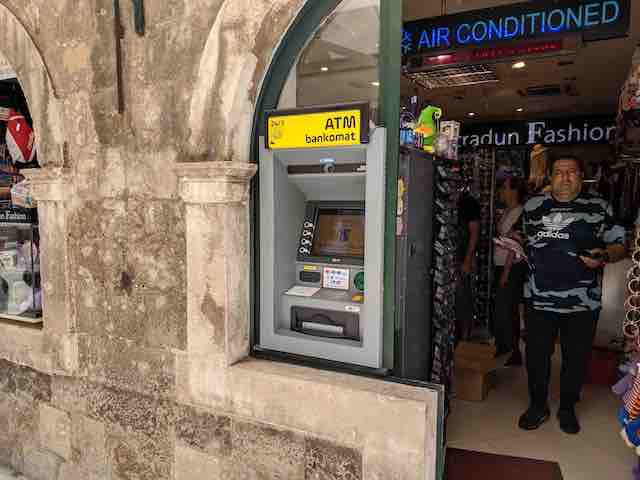If you had asked me a year ago where Croatia was, I’d have a hard time locating it on a map. Now, we were about to become intimately familiar with this mysterious country and its coastline. But first, we needed to be welcomed into the country by Mr. Customs and Mrs. Immigration. From fellow boaters and books we had read, I was prepared for a little more bureaucracy and a few more bucks to have the pleasure of sailing these waters. We were told that Croatia was more expensive than other Mediterranean countries. And back in Montenegro, one official warned us to be very careful to check in at the first available port. He told me the tale of two boats that had taken liberties with entering Croatian waters unofficially, one to seek safety during a storm, only to end up being fined over a thousand euros. That got my attention. As did the sleek sailboat docked behind him that had been confiscated by Montenegrin authorities for reasons that might get me killed if I asked. OK, maybe not that severe, but it is fair to say that the message had been delivered and we would be stopping at the town of Cavtat, just across the Croatian border, pronto.
The first challenge was med mooring using our own anchor. We felt pretty competent by now at the med mooring process. These are the sequence of steps used to back your boat into a dock, with the stern stopping just short of a collision, but close enough that you can get off the boat. Up to this point, we had used what are called ‘laid lines’. These lines run from the aforementioned near-collision dock out under the water several boat lengths to a large underwater concrete block. The idea is that you grab these lines from where they are tied onto the dock and carry them forward to the bow of your boat and cleat them on so that the boat doesn’t hit the dock, or get blown sideways into your neighbor’s boat who will, in the process, find a reason to assume all American boaters are clueless. What is at stake here is not only your home country’s reputation, but your own pride as a skipper. Few things distinguish a fine Mediterranean skipper than their ability to causally, almost effortlessly, med moor your boat, often in the narrowest of gaps between other fine craft. But again, this is all easily done when there is a laid line for you to pickup from the dock. What takes the challenge to the top is dropping your own anchor, as you are backing down to the dock, trying very carefully to not cross your anchor with someone else, and feeding the chain out at just the right speed so that you don’t slow down the speed of the boat, and therefore its maneuverability. With lots of crew, you can have one person dedicated to the anchor task. But with just Karen and I, it’s a multi-tasking nightmare. And Cavtat was to be the proving ground. Once we located the ‘Q’ dock (for ‘quarantine’, a carryover from when diseases from foreign countries were a real risk), we did a ‘drive-by’ to assess the situation, and head back out to drop our anchor. Aiding us immensely on this virgin run was the virtual lack of wind, and the complete absence of any other boats on the Q dock. I assumed the anchor role, and began letting out chain steadily, while Karen put Sea Rose in reverse. We had dock lines all ready to go at the stern too. Karen had backed down the boat plenty of times to know how to expertly keep it in a straight line. But we had set the anchor so far out in the harbor that we soon ran out of the 70 meters of chain, and started to transition to the nylon line extension. Concerned, I stopped letting out line, and the boat came to an abrupt stop half a boat length from the dock. Hmm, not what we needed! In the cockpit, Karen used the remote windlass control to let out more line as the boat approached the concrete dock and I tossed one of the stern lines to a man that suddenly appeared and offered to help. I had been prepared to jump on the dock myself to secure our lines; plenty of boaters in the Med have told stories of random people grabbing your lines, and then holding a hand out for an excessive amount of money for their efforts given that it was a 30 second task. But this guy ended up being the manager of the dock. We had both stern lines tied up in no time, snugged up the anchor line, and adjusted fenders on each side for other boat arrivals. Our first true Med moor experience, done! No sooner were we settled that a power boat started backing down to the dock right next to us. They had the opposite problem, dropping their anchor when the boat was only a few meters off the dock. This two-person affair were neophytes like us, but they were very tentative about backing the rest of the way to the dock, almost as if they had changed their mind and were having doubts about the whole idea. A cross wind had developed at this time, which sent them drifting into us. Hastily, we moved fenders, and told them to go out further to drop their anchor. How soon we had become experts in this endeavor, enough to give confident instructions to someone only slightly less experienced than us. Anyone familiar with being an IT consultant will easily recognize this scenario! They were soon tied up like us and the wind had died down to make us all friendly dock neighbors. I jumped ashore and was immediately approached by the dock manager to explain to me where to walk to clear into customs. And, oh by the way, he said it would cost me 100 kuna (about 15 USD) to dock for a maximum of 15 minutes. Off at a trot I went. Whenever I do this customs clearance, I must admit my mind wonders whether anyone really cares. It is not like you are arriving at London Heathrow, or JFK, and there is no way you could avoid the customs and immigration line. Here, I am walking through little streets, past cafes and restaurants, up a steep alleyway, to the port police office. Whose to say that I couldn’t just walk through town, grab a gelato, and welcome myself to Croatia. Alas, this was my day to let my rule-following self shine. And a good day for it. It was not obvious until I was inside the port police office, but they had several security screens showing the Q dock, what boats were on it, and clear views of anyone walking off their boats. I channeled the 10% of my British heritage into the polite mannerisms that are expected in these offices of bureaucracy. They took our boat registration and passports, and gave me a crude map, the kind that had been photocopied too many times, on where to walk to find the harbormaster’s office. Off I went at a healthy clip to make good use of our 15 minute docking window. I passed young couples and families with children wearing their sun hats and carrying their beach gear. ATM’s were around every corner and I stopped at one to deplete our bank account with plenty of kunas to cover the pleasure of sailing these waters. With some help from Google maps, I entered an official looking building with a large Croatian flag out front, down a dark hallway, where two other men were waiting. With the equivalent of over a thousand dollars of cash in my pocket, I was more than just a bit anxious. Who were these loitering men? They didn’t speak any English, but the woman who opened the office door awhile later did a bit, and when it became apparent I was in the line for welfare/public assistance, she swiftly re-directed me upstairs. The second floor was only slightly less dark, and even more hot and steamy. The gentleman behind the desk was a cheery fellow, with easy going English and ready to process me into the country. I usually approach these customs clearance tasks with a backpack full of boat and personal documents, as you never know who is going to need what, and whether they are prone to impatience as a nervous visitor drops their fistful of documents on the floor, as I have done more than once. After discussing the length that we wished to stay in Croatia, he said ‘OK, it has come to the most difficult part of the process’, with a pause for effect. I thought, “What now?” I had shown him my US Coast Guard captain’s license, a rare request for officials. What more could he need, and did I have it? He continued, “It is the matter of how much you owe”, with an ever so subtle smirk. He had clearly run these same lines by his previous visitors. To ease the pain, he suggested I pay for one month now, and when that time period expired, I could pay up for the remaining three weeks we planned to stay in Croatia. He tapped on his computer, then on his adding machine, and just like that, the total came to 2039 kuna for a one month stay, about $300. OK, so more than anywhere else we had sailed, but tolerable. He refused a credit card, and out of my pocket, and hopefully not into his own personal pocket, went the kunas that had so recently belonged to the ATM. I was instructed to return to the port police, and there, after some further formalities that I couldn’t discern, our passports were returned to me and I trounced back down to the Q dock. Although we didn’t appear any different to the other tourists we past, it felt good to be officially cleared in. We could now safely explore this great country everyone was raving about.

I handed over to the dock guy his 100 kuna ransom and we slipped our lines and motored out of the Cavtat harbor. The skies were darkening and the temperatures were such that long pants and a jacket were needed to ward off the elements. With no wind to speak of, we were left to motor the 10 miles north to Dubrovnik. I had spent a considerable amount of time figuring out where we could stop with Sea Rose here, and the best option appeared to be up the Rijecka river, on the northern outskirts of the city. Dubrovnik is a top tourist spot, but not very welcoming to visiting sailors. On the southern side, at the entrance to the historic old town, private boats were not welcome amongst the chaos of tour boat operators. On the north side of the city was the gargantuan cruise ship terminal, never a top choice for us, and adjacent to it was one marina that received very unpopular ratings from previous boaters. On the west of the city, in a cove surrounded by luxury resort hotels, there was no place to land a dinghy due to well attended swim areas. That left the Rijecka river which carried on for 4 miles into the interior, ending at the ACI Dubrovnik marina, one of many ACI member marinas along the Croatian coast. I didn’t even bother inquiring about a slip, as the per night cost of 180 euros was far out of our budget, and if one chose to make a reservation ahead of time, the marina charged you an additional 50% surcharge. We were starting to get the flavor of boating costs in Croatia. We opted instead to anchor in the river, just downstream from the marina, and chose to be a customer of theirs as much as we had to by doing laundry and buying provisions and fuel, but avoiding the big overnight dock bill. At least three quarters of the marina’s dock space was dedicated to the boat charter business. There were a few familiar names such as Sun Sail and Dream Yacht Charters, but far more names that we had not heard of. It seemed like everyone was getting into the charter trade here, whether they had one boat or thirty. We had never seen so many companies in operation before. It was a Tuesday when we arrived, and much of the dock space was empty, but we were told that it’s best to stay away on Friday or Saturday, when all of the boats come back in at the end of their charter week, get cleaned up, and head out again. The sun-burned departees pile into the same airport taxis that the pale skinned new arrivals just climbed out of. Clearly this was a major economic linchpin in the country.
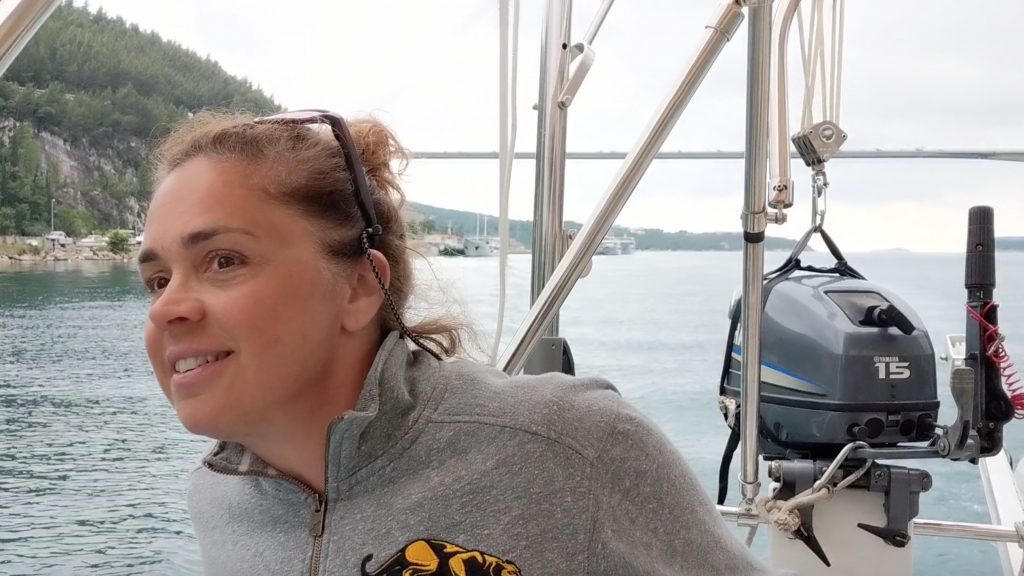
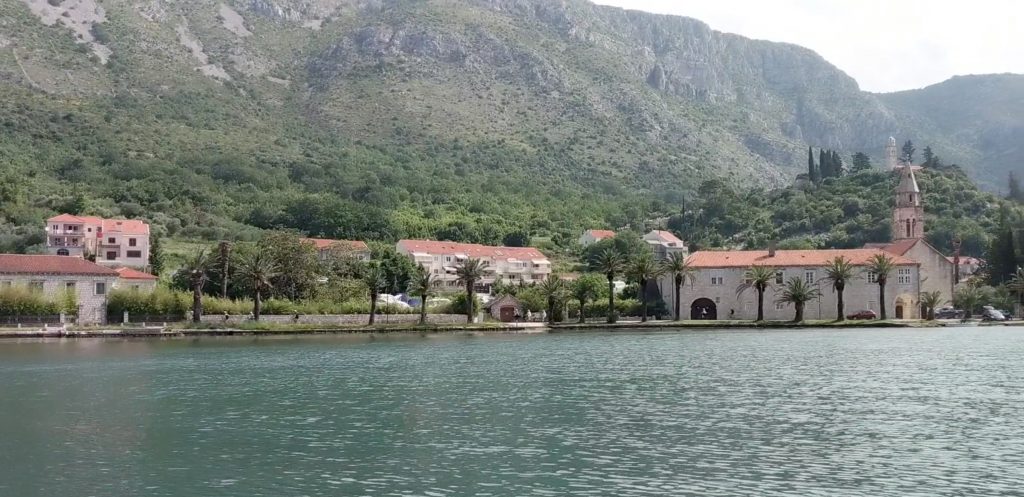
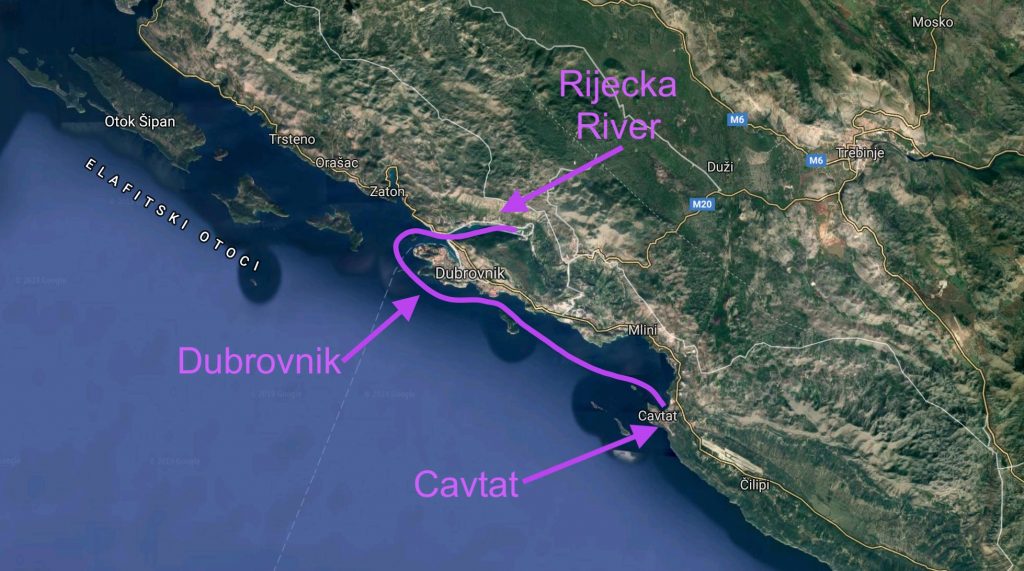
After completing a few chores on the boat, Karen and I figured we could afford a ‘play day’ off the boat before our next guests arrived. Our arrival in Dubrovnik was timed to pick up my brother Todd and his wife and two of their young adult children. But we had managed to get cleared in and settled with a day to spare.
Dubrovnik was one of the few towns we had visited where Uber operated, but we decided instead to take the local bus and try to mingle as a local would do. We were headed to Pile Gate, the entrance to the famed old city center of Dubrovnik, and I think most everyone else on the bus was a tourist, but at least we had made the effort!
To our delight, the skies had cleared and the sun shown brightly. The weeks prior, with their on again/off again rain storms, had passed and it felt like someone up in the sky had flipped the switch over to the summer setting. Off came the long pants and fleeces. This was the start of shorts and t-shirt weather.
We had been warned about the crowds in Dubrovnik, and indeed several large cruise ships had pulled into port while we had been sleeping the previous night. It’s an unavoidable reality that the beautiful sites to see are inevitably full of others that have the same idea. With the internet and the free flow of information and reviews, there are few secrets out there. And, with a world that only gets more populated, you have to put up with the crowds, the sweat, and the cameras, or you will find yourself never leaving home.

Dubrovnik has been given the nickname ‘The Pearl of the Adriatic’ and it is clear why. Medieval walls tower over the old city and stone masonry is heavily at work on the streets and buildings within the walls. Likely the most popular attraction is to walk the wall. The pedestrian flow only goes in one direction, and in some spots there is only width enough for one person, but the upside is that you are afforded ever changing, impressive views looking out on the Adriatic and looking inward on the red tile rooftops of the interior. It is no wonder that the location scouts selected this old city for a lot of the filming of Game of Thrones. Pass a long sword to a kilt-wearing scruffy young warrior, light some torches under a full moon, and no one would question the authenticity of the scene. We tried to be patient while yet another camera-clutching Japanese tourist stopped all traffic on the wall to get the perfect picture (or 20) of their red-lipsticked model female posing provocatively. But I’m being unfair. I’m sure I would irritate them if I were taking in the sights and slowing down traffic in Tokyo.
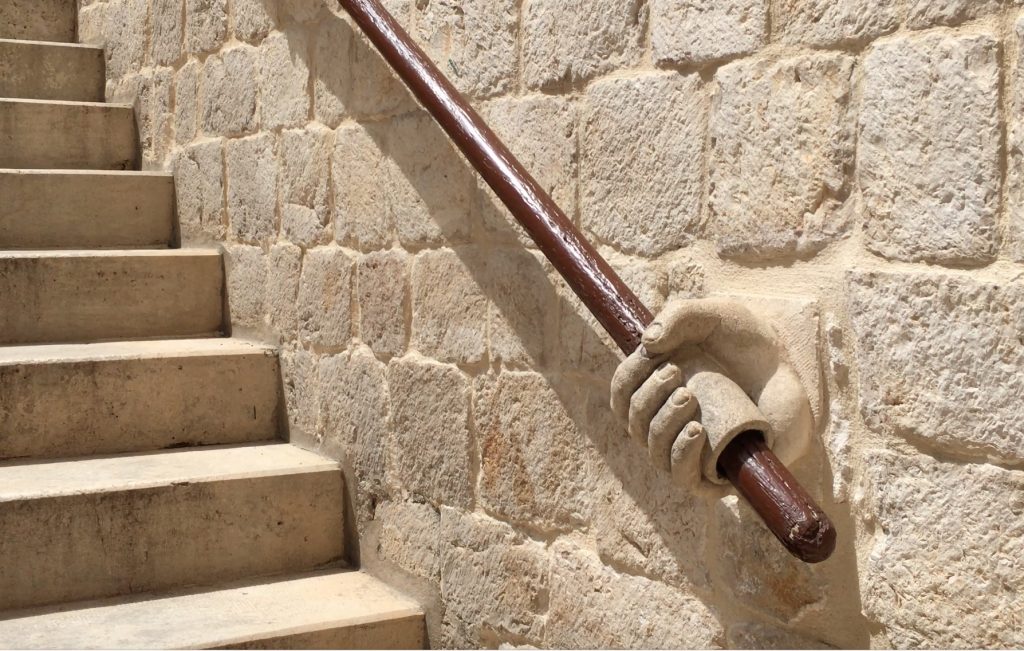

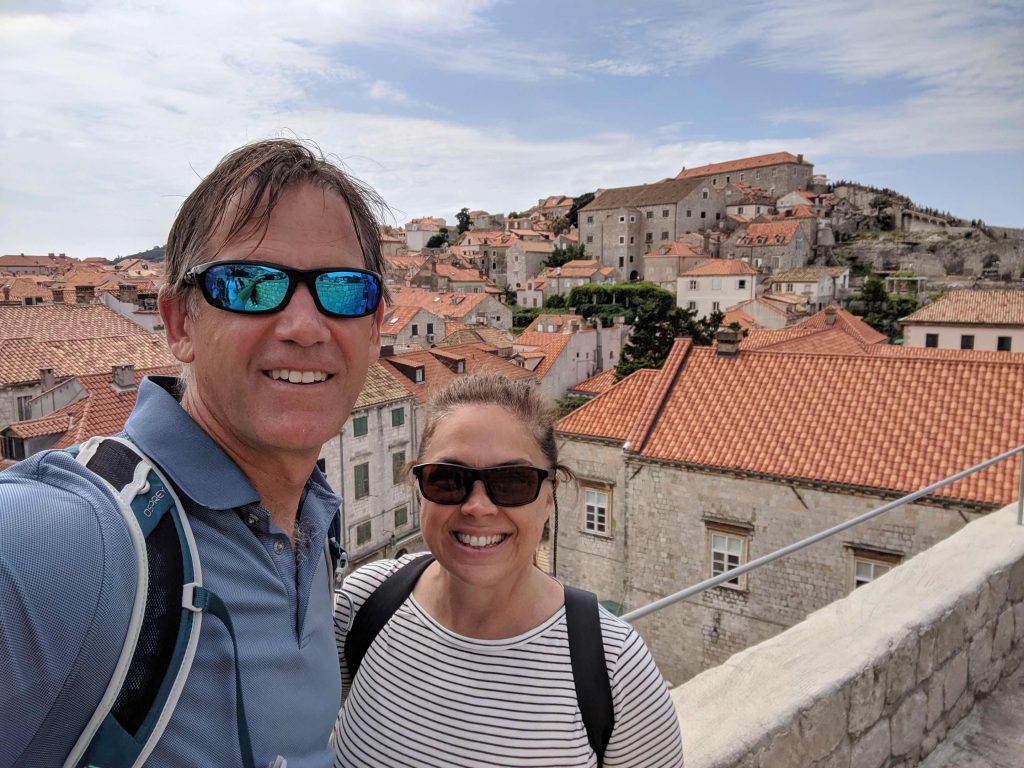
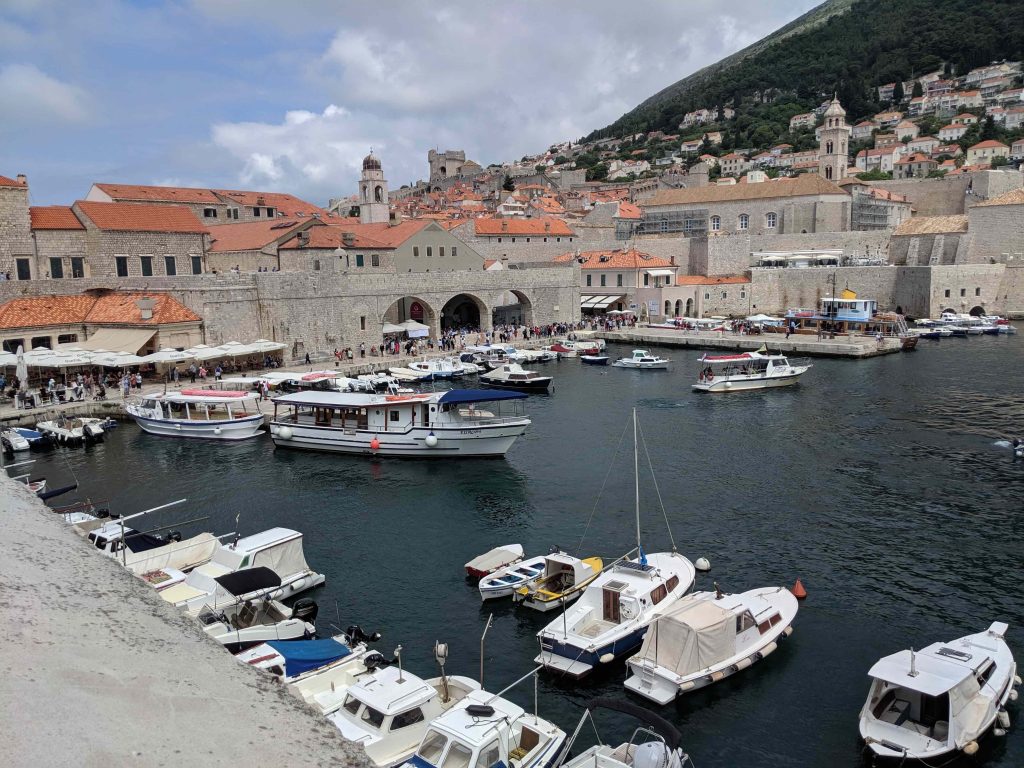
I was shocked by the impact of the sun’s heat and all of the surrounding stone work. It really felt like a wholesale change in seasons. The heat of summer was now upon us. You only have yourself to blame if you’re not prepared with hat, water bottle, and dri-fit shirt. In fact, they had positioned a first aid team partway around the wall for just this issue. We opted for a relaxing lunch in a heavily shaded alleyway off the main walking street. This main street promenade, used numerous times apparently in Game of Thrones, took no more than 5 minutes to walk its length, but it seemed like the merchants of this old city felt it was highly likely you would spend all of your kunas before reaching the other end. I was shocked by how many ATM’s existed along this main thoroughfare. Did they not accept credit cards in this town? Did they think all of us tourists would throw ourselves upon every souvenir shop, buying up refrigerator magnets until we bent the north pole to our will? I finally resigned to count and document how many of these crazy cash dispensing devices really existing on this walkway. The answer? 24! Shocking! Here’s the proof.

The sudden change in climate, while welcoming when compared to the alternative of gray rainy skies, was starting to take its toll on both Karen and I. We found a few museums to get out of the heat. Karen checked out the cultural history museum named the Rector’s Palace while I chose the Maritime museum (no surprise there). They both provided relief from the persistent heat, but I would not recommend you come to Dubrovnik just to take in the museums. Walking the walls, having a meal at a cafe hidden down an alleyway, and perhaps ending the day with a kayak around the waterfront are far superior ways to enjoy the Pearl of the Adriatic.
Back on the local bus, we stopped near the cruise ship terminal to check out a nearby shopping mall. I must admit an infatuation with retail stores when we travel. I like nothing more than to wander the aisles and see what other countries sell that we don’t have at home. Household goods in particular are my weakness. I’m certainly not going to pack home a kitchen mixer, floor lamp or set of security cameras. But presented with the same household challenge, I am forever fascinated about how designers separated by oceans come up with often widely different solutions to the same problem, and in the process make you question what you thought was the ‘right’ way. Opening up your mind and making you question – this is what travel is to me. However, shopping malls here are not like those at home that warrant an entire exit ramp off the highway. Like so many other things in Europe, they were smaller, much smaller. Or maybe Europeans look at American institutions like the mall or the highway and wonder why we insist on making them all so excessively over-sized. The more time Karen and I spend in Europe, the more I wonder myself. At this particular mall in Dubrovnik, you had all the mall fundamentals contained in a single multi-story building, with floors connected with mostly operating escalators. The whole affair might take less than the footprint of one anchor store back home. These space saving Croats will fit in several clothing stores, a pharmacy, a home goods/furniture store, a few ubiquitous cell phone stores or kiosks, and at least a few shoe stores. But, the vibe was all off. It’s like the town felt like they had to get in step with the modern times and have a modern mall, but the passion wasn’t there. This lack of passion carried over to customers too. It seemed like they were walking around trying their best to look for something, and it was chronically missing. What’s missing is the old-world charm of a real shopping experience, with little boutique shops lining a cobble-stone street with little round cafe tables consuming sidewalk space causing you to slow down and take in what only an old European city can provide – a city steeped in history with eye-catching architecture made up of pale stone and old streetlights and micro-sized store fronts run by multi-generational merchants who take great pride in their offerings, irregardless of whether they are still made locally or halfway around the globe. OK, so maybe the old city center of Dubrovnik doesn’t offer all of this, but it sure beats the monochromatic American mall experience. I was definitely one of those glassy-eyed consumers in the Dubrovnik modern mall complex, searching for more, and not finding it.
With some searching to find the right bus route, we eventually made it back to the boat, full of the weariness of being on foot, but reveling in the joy of a whole day dedicated to play – no anchors to set and no wind shifts to trim to. We had left the driving up to others and engrossed ourselves in the pleasure of being a normal tourist. Tomorrow, my brother and his family would be coming onboard for a week of Croatian sailing. Todd and I had tried to put this week together last summer, but family events got in the way, so I couldn’t wait to welcome him onboard this summer. Like many siblings, we had both pursued dreams that took us far apart geographically, and time together was hard to make happen given the many tentacles that family and career create. But soon we would correct that, and where else but in beautiful Croatia!






